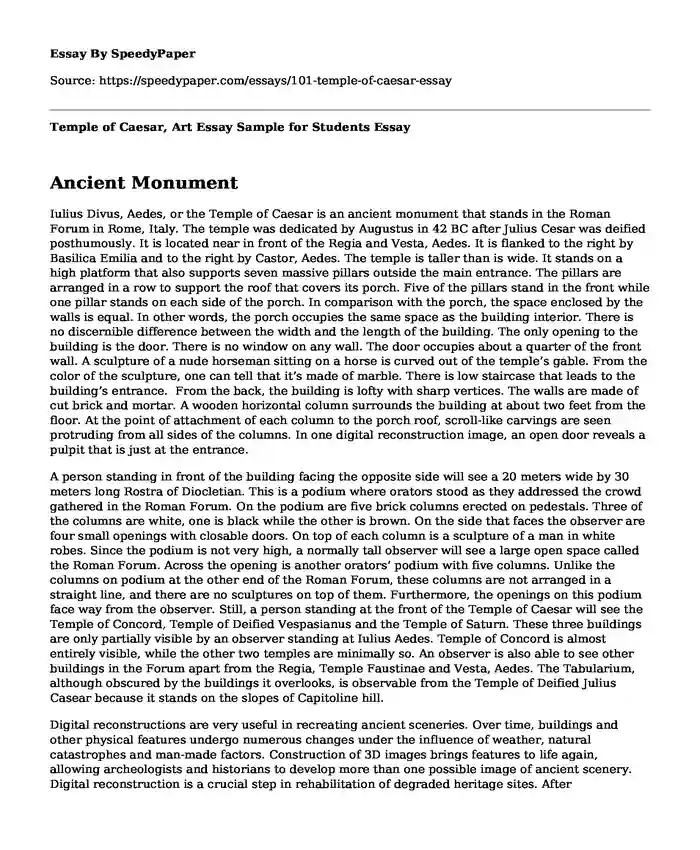
| Type of paper: | Essay |
| Categories: | History Architecture Sculpture Julius Caesar Ancient history |
| Pages: | 4 |
| Wordcount: | 861 words |
Ancient Monument
Iulius Divus, Aedes, or the Temple of Caesar is an ancient monument that stands in the Roman Forum in Rome, Italy. The temple was dedicated by Augustus in 42 BC after Julius Cesar was deified posthumously. It is located near in front of the Regia and Vesta, Aedes. It is flanked to the right by Basilica Emilia and to the right by Castor, Aedes. The temple is taller than is wide. It stands on a high platform that also supports seven massive pillars outside the main entrance. The pillars are arranged in a row to support the roof that covers its porch. Five of the pillars stand in the front while one pillar stands on each side of the porch. In comparison with the porch, the space enclosed by the walls is equal. In other words, the porch occupies the same space as the building interior. There is no discernible difference between the width and the length of the building. The only opening to the building is the door. There is no window on any wall. The door occupies about a quarter of the front wall. A sculpture of a nude horseman sitting on a horse is curved out of the temple’s gable. From the color of the sculpture, one can tell that it’s made of marble. There is low staircase that leads to the building’s entrance. From the back, the building is lofty with sharp vertices. The walls are made of cut brick and mortar. A wooden horizontal column surrounds the building at about two feet from the floor. At the point of attachment of each column to the porch roof, scroll-like carvings are seen protruding from all sides of the columns. In one digital reconstruction image, an open door reveals a pulpit that is just at the entrance.
A person standing in front of the building facing the opposite side will see a 20 meters wide by 30 meters long Rostra of Diocletian. This is a podium where orators stood as they addressed the crowd gathered in the Roman Forum. On the podium are five brick columns erected on pedestals. Three of the columns are white, one is black while the other is brown. On the side that faces the observer are four small openings with closable doors. On top of each column is a sculpture of a man in white robes. Since the podium is not very high, a normally tall observer will see a large open space called the Roman Forum. Across the opening is another orators’ podium with five columns. Unlike the columns on podium at the other end of the Roman Forum, these columns are not arranged in a straight line, and there are no sculptures on top of them. Furthermore, the openings on this podium face way from the observer. Still, a person standing at the front of the Temple of Caesar will see the Temple of Concord, Temple of Deified Vespasianus and the Temple of Saturn. These three buildings are only partially visible by an observer standing at Iulius Aedes. Temple of Concord is almost entirely visible, while the other two temples are minimally so. An observer is also able to see other buildings in the Forum apart from the Regia, Temple Faustinae and Vesta, Aedes. The Tabularium, although obscured by the buildings it overlooks, is observable from the Temple of Deified Julius Casear because it stands on the slopes of Capitoline hill.
Digital reconstructions are very useful in recreating ancient sceneries. Over time, buildings and other physical features undergo numerous changes under the influence of weather, natural catastrophes and man-made factors. Construction of 3D images brings features to life again, allowing archeologists and historians to develop more than one possible image of ancient scenery. Digital reconstruction is a crucial step in rehabilitation of degraded heritage sites. After reconstruction of an ancient site using 3D computer models, architects and engineers can then construct the sites using modern techniques to end up with structures that mimic the original ones. Reconstruction of the ancient world can speak volumes about the organization of ancient societies. Several features were monumental in the past, and served religious or political functions. The shape, size, symbolism and location of a specific feature tell about the value attached to it by the society. For example, the location of the Temple of Deified Julius Caesar in the East side of the Roman Forum and adjacent to the Basilica Emilia says much about the legacy of Julius Caesar as a religious and political figure. Compared to other models of ancient reconstruction, digital reconstruction is fast, accurate and reliable. Excavation, for example, is time consuming, unreliable and unproductive. Scientists often follow remote leads to various sites and artifacts, which might not always be correct. In the process of excavation, archeologists might come across interesting objects that were not part of their original mission. Such artifacts might divert their attention or influence their line of thought in the reconstruction process. Digital reconstruction, however, is objective and straight to the point. It is therefore recommended to use digital reconstruction to improve on quality and accuracy of recovery.
Cite this page
Temple of Caesar, Art Essay Sample for Students. (2018, Sep 04). Retrieved from https://speedypaper.net/essays/101-temple-of-caesar-essay
Request Removal
If you are the original author of this essay and no longer wish to have it published on the SpeedyPaper website, please click below to request its removal:
- Free Essay Sample: Living with HIV
- Free Essay on Louis Farrakhan and the American Jews
- Marketing Essay Example: Abano Dental Clinic
- Essay Example: Captain Sullenberger Research
- Role of Presidential Speech on Public Approval, Free Essay in Political Science
- Rhetorical Analysis Essay Sample of a Crime of Compassion by Barbara Huttmann
- Essay Sample on Microsoft Queries and Clinical Services
Popular categories




